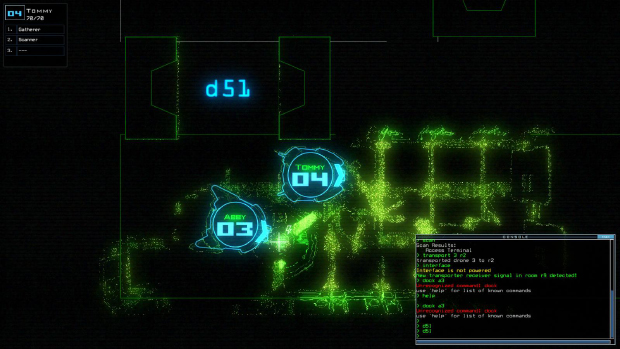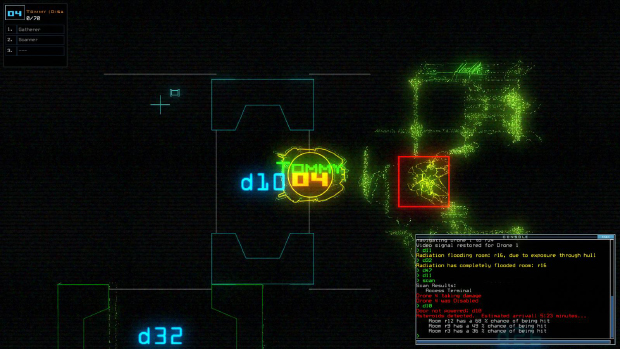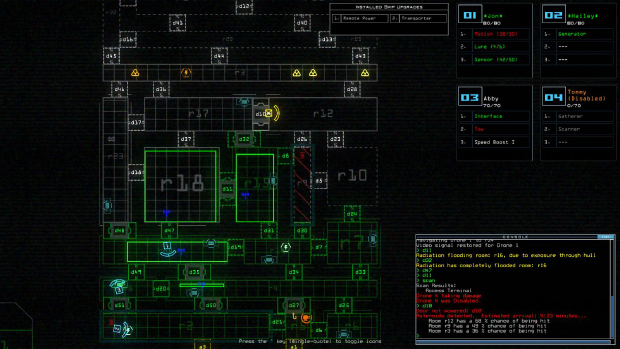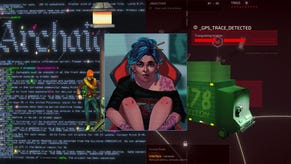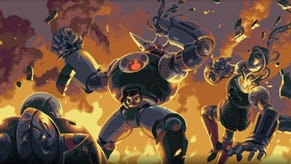Premature Evaluation: Duskers
Drone Alone
Each week Marsh Davies pulls apart the fritzing hulks he discovers drifting through the lifeless void of Early Access and comes back with any stories he can find and/or accidentally flushes himself out of an airlock. This week he’s been tentatively probing Duskers, a space-set roguelike in which you remotely operate a crew of drones as they strip derelicts of resources and attempt to uncover the reason for the dramatic depopulation of the galaxy.
Duskers uses a command line interface. This is how I know it’s a really good game: I would normally hate that. As regular readers will know, having nostalgia for inefficient game control schemes of yore makes as much sense to me personally as having nostalgia for rickets or open sewers. I accept that I may be in the minority here but, in any case, Duskers’ command line interface isn’t laying claim to some misty-eyed notion of The Good Old Days; its inarticulacy and inefficiency are part of the game’s expert orchestration of tension. For the most part, the game is intently methodical - a sort of poised, precise sloth that feeds the fantasy of this remote and lonely operation as you coax your four rapidly-deteriorating drones through the clutter of equally rapidly-deteriorating space-stations, hoping to recover enough fuel to make the next jump.
But then the screws tighten.
Several unprofitable salvage operations in a row and the fuel tanks are looking pretty parched. You simply lose the luxury of turning back, even as the derelict station rocks from asteroid impacts, even as radiation leaks through its hull, even as your drones’ motion detectors give out and their cameras gutter into blackness. On the other side of a door might be the haul your survival demands, or it might be something with an awful lot of teeth. And suddenly - very, very suddenly - the game becomes one of recalling and executing recherche syntax under pressure, as you send your drones into flight, slamming doors to cover their exit, flushing rooms into the vacuum or activating sentries in a flurry of fat-fingered keyboard hammering. Maybe you’ll do better, but the deformed hooves I call hands would reduce Mavis Beacon to plangent weeping. I probably mistyped half the words in that sentence, even. Under the threat of Space Peril, I am likely a dead man.
Luckily, you do get direct control over your drones, too. The game is divided between a schematic mode solely operated by the command line, and direct WASD control of individual drones from a top-down view, rendered as it’s seen through your drone’s fuzzy optical sensors. Or, sometimes, as it’s not seen: if your drone’s camera signal is lost, even temporarily, you have little choice but to flit over to the schematic mode. Given that you can only control one drone directly at a time, it’s sometimes more efficient to tap out “navigate 1 2 3 4 r1” to get your entire crew heading back to the airlock in Room 1, switching to the overhead view to unhitch stragglers from obstructions, and generally trying not to panic as radiation billows in from a nearby hull-breach.
It’s not just the two methods of control that require negotiation but the individual skills of your drones, too. Each has four slots for such upgrades, allowing you to specialise or build in redundancy as you see fit. Jon, my number one drone, who responds to commands with a prissy-sounding biddly-beep, is my scout - an essential role given the unknowable horrors that might lurk the other side of any given door. When stationary, he can sweep adjacent rooms for movement and has a number of sensors that can be plonked down to continually detect motion in a single room. Then there’s the tension of waiting. Duskers is a surprisingly potent aesthetic experience: the low moan of ship mechanisms, the whirrs and clicks of your drones, the static buzz of the interface - all create a pregnant, lonely quiet which is then suddenly punctured by a shrill alarm as the green sweeping sensors turn red.
Hostile lifeforms will attack and disable drones in short order, so it’s necessary to avoid, trap or dispatch them by cunningly manipulating the ship’s systems. Hailey, my number two drone, who says hello with a shrill brrrrp, is equipped with a generator. Once a power inlet is located, Hailey can plug herself in to power whatever doors and systems are associated with it. Typing the name of a powered door will now open or shut it, and, with a judicious use of Jon’s sensors and deployable lures, it’s possible to usher the creature into an empty cupboard, or better still, into a room with an active sentry turret in there. That’s (ble-boop) Abby’s job: she has an Interface upgrade that allows her to access ship control panels and turn on the powered defence systems. A last resort is to flush the creature into the vacuum by opening an airlock, but this has the side effect of contaminating the ship interior with radiation that will quickly damage the drones and spread between open rooms.
I found my fourth drone, Tommy (bad-da-le-beep), during a salvage operation: he was disabled, so I had to use Abby’s Tow upgrade to haul him back to the airlock. After repairing him, I switched around some of the skills among my existing drones to make Tommy a dedicated resource gatherer - the only upgrade so fundamental that you can craft a drone with it pre-fitted from the get-go, assuming you have already gathered the requisite amount of scrap. You’ll also need scrap for repairs: drones’ upgrades fail the longer they are in the field and many of these skills, like sensors, lures and even uses of the motion detector, are consumable items that need to be replenished by snaffling up scrap as well. You’ll need fuel, too, for propulsion between derelict vessels within a given star system, and j-fuel for making the longer jumps around the galaxy. There’s also a universe map, but I haven’t yet got far enough to see its purpose.
As you go, you’ll begin to piece together the reasons for humanity’s apparent demise from ship logs, and gain new pointers for where to head next. Could the advancement of nanotechnology have led to the accidental molecular reassembly of humankind? Could a catastrophic war have precipitated an avalanche of other crises that eventually extinguished all life? These questions were far from answered on my first playthrough, and I was initially worried that the cruel roguelike structure of the game would be in contradiction to the rather slow process of unravelling the game’s mystery. It’s a tough game - and perhaps not entirely gratifyingly so in its current Early Access build. Calamities accelerate the further you get in, and, while sudden threats initially force improvisation, their accumulation quickly begins to shut down your choices, sending your mission into a lengthy but entirely inescapable death spiral.
On my drones’ final fateful expedition, the teleporter bays I’d used to board the ship lost signal, leaving me only one route of escape at the far side of the derelict. Inconveniently, this was now being pounded by an asteroid storm, leaving many of the vital thoroughfares full of holes. Jon’s motion detector’s conked out, forcing me to move forward blindly. Consequently, Tommy got eaten, and, along with him, any possibility of gathering the fuel I needed to make a further jump. Even if I could have safely reached him, Abby’s tow upgrade had broken. Further exploration revealed no way to power the doors which barred my drones from escape - perhaps a glitch of the procedural generation or an intentionally cruel circumstance. Radiation began to seep through the hull.
This certain doom, the seeds of which were sewn across the previous hours of procedurally generated but unavoidable misfortune, would be aggravating if it meant recovering all the evidence I had so far accumulated from scratch. Instead, Duskers allows you to reset in the face of oblivion and yet still import all your existing knowledge, starting again with a new set of drones and, seemingly, an equivalent difficulty level to that reached in your abandoned game. I will shed a tear for my biddly-beeping pals, but I’m no less eager to see how Ian, Vinnie and Kyle fare in the face of interstellar peril with their very different set of skills.
Duskers plans to be in Early Access for another three-to-six months, during which time the storylines will be completed, and extra upgrades and modifications added. I think it’s about as exciting a game as I’ve played for this column, by turns offering measured, ruminative strategy and then exhilarating panic. New drone builds should provide added richness to the strategy, and, hopefully, offer more opportunity for you to successfully improvise your way out of catastrophe, but even in its half-complete state, Duskers offers quite a voyage indeed.
Duskers is available from Steam for £15. I played the version with the Build ID 741957 on 21/08/2015.



